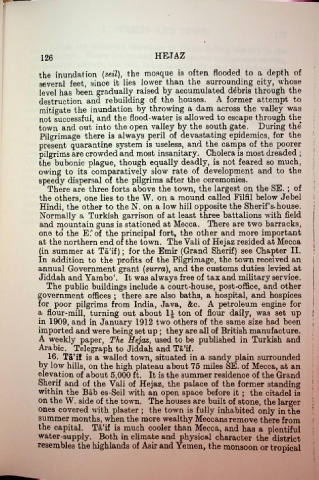Page 62 - A Hand book of Arabia Vol 1 (iii) Ch 4,5
P. 62
126 HEJAZ
the inundation (seil), the mosque is often flooded to a depth of
several feet, since it lies lower than the surrounding city, whose
level has been gradually raised by accumulated debris through the
destruction and rebuilding of the houses. A former attempt to
mitigate the inundation by throwing a dam across the valley was
not successful, and the flood-water is allowed to escape through the
town and out into the open valley by the south gate. During the
Pilgrimage there is always peril of devastating epidemics, for the
present quarantine system is useless, and the camps of the poorer
pilgrims are crowded and most insanitary. Cholera is most dreaded ;
the bubonic plague, though equally deadly, is not feared so much,
owing to its comparatively slow rate of development and to the
speedy dispersal of the pilgrims after the ceremonies.
There are three forts above the town, the largest on the SE. ; of
the others, one lies to the W. on a mound called Filfil below Jebel
:
Hindi, the other to the N. on a low hill opposite the Sherif’s.house. ;
Normally a Turkish garrison of at least three battalions with field
and mountain guns is stationed at Mecca. There are two barracks,
one to the E'.‘ of the principal fort, the other and more important
at the northern end of the town. The Vali of Hejaz resided at Mecca
(in summer at Ta’if); for the Emir (Grand Sherif) see Chapter II.
In addition to the profits of the Pilgrimage, the town received an
annual Government grant (surra), and the customs duties levied at
Jiddah and Yambo‘. It was always free of tax and military service.
The public buildings include a court-house, post-office, and other
government offices ; there are also baths, a hospital, and hospices
for poor pilgrims from India, Java, &c. A petroleum engine for
a flour-mill, turning out about If- ton of flour daily, was set up
!
in 1909, and in January 1912 two others of the same size had been
imported and were being set up; they are all of British manufacture.
A weekly paper, The Hejaz, used to be published in Turkish and
Arabic. Telegraph to Jiddah and Ta’if.
16. Ta’if is a walled town, situated in a sandy plain surrounded
by low hills, on the high plateau about 75 miles SE. of Mecca, at an
elevation of about 5,000 ft. It is the summer residence of the Grand
Sherif and of the Vali of Hejaz, the palace of the former standing
within the Bab es-Seil with an open space before it ; the citadel is
on the W. side of the town. The houses are built of stone, the larger
ones covered with plaster ; the town is fully inhabited only in the
summer months, when the more wealthy Meccans remove there from
the capital. Ta’if is much cooler than Mecca, and has a plentiful
water-supply. Both in climate and physical character the district
resembles the highlands of Asir and Yemen, the monsoon or tropical

